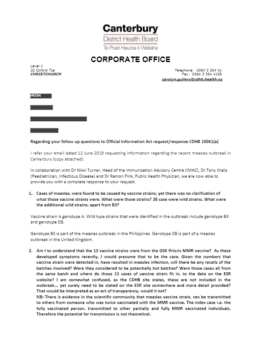Official information request details
- Cases of measles, were found to be caused by vaccine strains, yet there was no clarification of what those vaccine strains were. What were those strains? 38 case were wild strains. What were the additional wild strains, apart from B3?
- Am I to understand that the 13 vaccine strains were from the GSK Priorix MMR vaccine? As these developed symptoms recently, I would presume that to be the case. Given the numbers that vaccine strain were detected in, have resulted in measles infection, will there be any recalls of the batches involved? Were they considered to be potentially hot batches? Were those cases all from the same batch and where do those 13 cases of vaccine strain fit in, to the data on the ESR website? I am somewhat confused, as the CDHB site states, these are not included in the outbreak... yet surely need to be stated on the ESR site somewhere and more detail provided? That would be interpreted as an act of transparency, would it not?
NB: There is evidence in the scientific community that measles vaccine strain, can be transmitted to others from someone who was twice vaccinated with the MMR vaccine. The index case i.e. the fully vaccinated person, transmitted to other partially and fully MMR vaccinated individuals. Therefore the potential for transmission is not theoretical. - What assurances will you be offering to the public who have received the GSK vaccine, who also may experience vaccine strain measles? Could more people be experiencing symptoms, but having had the vaccine, not notify anyone, believing that they were protected? If so, could these also be potentially vaccine strain cases, therefore your number of 13, be higher in fact?
- Given that there is evidence of the vaccine virus being capable of being transmitted to others, in the scientific literature, what public notification will the CDHB be offering, if at all, to inform about this, as this has ramifications for Community Immunity, as well as the process of Informed consent, under risks and benefits, does it not?
- By excluding the 13 cases from the outbreak, this may confuse the public and result in a lack of confidence in the vaccine itself and given that the Mayo Clinic's own vaccine scientist, Dr Gregory Poland has himself stated in Pub Med papers, that measles is becoming a disease of the vaccinated and that a new vaccine is needed, does this not raise some concerns for the CDHB?
- How many of the cases that are listed on the ESR website who were under 15 months of age and also above 15 months of age and under 4 years old, were in fact NOT being breastfed, which may have afforded them maternal transfer of antibodies and therefore protection? How many of those mothers had been vaccinated in the past, with the MMR vaccine, whose infants contracted measles?
- If 236 people who notified the authorities were investigated, what specific investigations were undertaken, as I was informed by ESR, that not all cases were investigated by lab testing, and some were confirmed by association only? I note that Hospitalisations are listed on ESR database. This would not presumably indicate how many were actually 'admitted,' to a ward, with a proportion of those spending about 3 hours on average in the Accident and Emergency Department, before being sent home. Some people attend the hospital in order to avoid the expense of the After Hours of course, or incurring a charge for attending their GP clinic.
- If those who were confirmed as having measles by reliable lab testing and to have 'vaccine strain measles' which will not be included in the outbreak, how many of their contacts who also developed measles, were tested by the RT-PCR test, to determine if they also had vaccine strain measles?
- Why has GSK not been mentioned in the CDHB information, in regard to the 13 vaccine strain cases? That was one of my questions in the OIA. Are they notified about these cases?
- Will the vaccine strain cases be reported to NZ CARM and reported on both databases? Do you consider this to be a vaccine failure, measles, or an adverse reaction?
- When will the media and the wider public be informed about the genotype results? They are not found easily when one goes to the site.
- What are those who had vaccine strains actually told? Will the fact that they have experienced a milder form of measles, result in any type of 'cell mediated immunity' and what strains will they be immune to? Is there any likelihood that there could be a problem with mutations for those people?
- Given that the numbers of cases who have been infected is just 38 wild strain and 13 vaccine strain cases and a significant number of those would not have been of an age, when they would be administered the vaccine due to their age, whilst others were either partially or fully vaccinated with the MMR vaccine, yet still contracted measles, what do you see this latest information suggests, about Community Immunity and how this vaccine is perceived, regarding its efficacy and the science that is evolving, around Adversomics and Genomics, both being integral parts of immune response and best health outcomes?
- Will all other DHBs be providing the same type of information on genotyping of cases on their websites, as that collated information becomes available?

